Vertical Seismic-Profile Data Local Full-Waveform Inversion Based on Marchenko Redatuming
Abstract
:1. Introduction
2. Principles and Methods
2.1. Local FWI Based on Standard Marchenko Redatuming
2.2. Standard Marchenko Redatuming
2.3. Marchenko Source-Receiver Redatuming with VSP Data
2.4. VSP-Driven Local FWI Method
3. Example
4. Discussion
5. Conclusions
Author Contributions
Funding
Institutional Review Board Statement
Informed Consent Statement
Data Availability Statement
Acknowledgments
Conflicts of Interest
References
- Gray, S.H.; Etgen, J.; Dellinger, J.; Whitmore, D. Seismic migration problems and solutions. Geophysics 2001, 66, 1622–1640. [Google Scholar] [CrossRef]
- Landa, E. Seismic diffraction: Where’s the value? In SEG Technical Program Expanded Abstracts; Society of Exploration Geophysicists: Las Vegas, NV, USA, 2012. [Google Scholar] [CrossRef]
- Decker, L.; Janson, X.; Fomel, S. Carbonate reservoir characterization using seismic diffraction imaging. Interpretation 2015, 3, 21–30. [Google Scholar] [CrossRef]
- Tarantola, A. Inversion of seismic reflection data in the acoustic approximation. Geophysics 1984, 49, 1259–1266. [Google Scholar] [CrossRef]
- Tarantola, A. A strategy for nonlinear elastic inversion of seismic reflection data. Geophysics 1986, 51, 1893–1903. [Google Scholar] [CrossRef]
- Pratt, R.G. Seismic waveform inversion in the frequency domain, Part 1: Theory and verification in a physical scale model. Geophysics 1999, 64, 659–992. [Google Scholar] [CrossRef] [Green Version]
- Ben-Hadj-Ali, H.; Operto, S.; Virieux, J. Velocity model building by 3D frequency-domain, full-waveform inversion of wide-aperture seismic data. Geophysics 2008, 73, 101–117. [Google Scholar] [CrossRef] [Green Version]
- Takougang, E.M.T.; Ali, M.Y.; Bouzidi, Y.; Bouchaala, F.; Sultan, A.A.; Mohamed, A.I. Characterization of a carbonate reservoir using elastic full-waveform inversion of vertical seismic profile data. Geophys. Prospect. 2020, 68, 1944–1957. [Google Scholar] [CrossRef]
- Lu, R. Revealing overburden and reservoir complexity with high-resolution FWI. In SEG Technical Program Expanded Abstracts; Society of Exploration Geophysicists: Dallas, TX, USA, 2016. [Google Scholar] [CrossRef]
- Alford, R.M.; Kelly, K.R.; Boore, D.M. Accuracy of finite-difference modeling of the acoustic wave equation. Geophysics 1974, 39, 834–842. [Google Scholar] [CrossRef] [Green Version]
- Routh, P.; Neelamani, R.; Lu, R.; Lazaratos, S.; Braaksma, H.; Hughes, S.; Saltzer, R.; Stewart, J.; Naidu, K.; Averill, H.; et al. Impact of high-resolution FWI in the Western Black Sea: Revealing overburden and reservoir complexity. Lead. Edge 2017, 36, 60–66. [Google Scholar] [CrossRef]
- Yuan, S.; Fuji, N.; Singh, S.; Borisov, D. Localized time-lapse elastic waveform inversion using wavefield injection and extrapolation: 2-D parametric studies. Geophys. J. Int. 2017, 209, 1699–1717. [Google Scholar] [CrossRef]
- Yuan, S.; Fuji, N.; Singh, S. High-frequency localized elastic full-waveform inversion for time-lapse seismic surveys. Geophysics 2021, 86, 277–292. [Google Scholar] [CrossRef]
- Cui, T.; Rickett, J.; Vasconcelos, I.; Veitch, B. Target-oriented full-waveform inversion using Marchenko redatumed wavefields. Geophys. J. Int. 2020, 223, 792–810. [Google Scholar] [CrossRef]
- Guo, Q.; Alkhalifah, T. Target-oriented waveform redatuming and high-resolution inversion: Role of the overburden. Geophysics 2020, 85, 525–536. [Google Scholar] [CrossRef]
- Robertsson, J.O.; Chapman, C.H. An efficient method for calculating finite-difference seismograms after model alterations. Geophysics 2020, 65, 907–918. [Google Scholar] [CrossRef]
- Guo, Q.; Alkhalifah, T. Target-oriented inversion with least-squares waveform redatuming. In SEG Technical Program Expanded Abstracts; Society of Exploration Geophysicists: San Antonio, TX, USA, 2019. [Google Scholar] [CrossRef]
- Li, Y.; Alkhalifah, T. Target-oriented high-resolution elastic full-waveform inversion with an elastic redatuming method. Geophysics 2022, 87, 379–389. [Google Scholar] [CrossRef]
- Wapenaar, K.; Broggini, F.; Slob, E.; Snieder, R. Three-dimensional single-sided Marchenko inverse scattering, data-driven focusing, Green’s function retrieval, and their mutual relations. Phys. Rev. Lett. 2013, 110, 084301. [Google Scholar] [CrossRef] [Green Version]
- Wapenaar, K.; Slob, E. On the Marchenko equation for multicomponent single-sided reflection data. Geophys. J. Int. 2014, 199, 1367–1371. [Google Scholar] [CrossRef] [Green Version]
- Slob, E.; Wapenaar, K.; Broggini, F.; Snieder, R. Seismic reflector imaging using internal multiples with Marchenko-type equations. Geophysics 2014, 79, 63–76. [Google Scholar] [CrossRef] [Green Version]
- van der Neut, J.; Vasconcelos, I.; Wapenaar, K. On Green’s function retrieval by iterative substitution of the coupled Marchenko equations. Geophys. J. Int. 2015, 203, 792–813. [Google Scholar] [CrossRef]
- Chen, X.; Hu, Y.; Huang, X.; Zhang, H.; Xu, Y.; Tang, J. Marchenko imaging based on self-adaptive traveltime updating. Appl. Geophys. 2020, 17, 81–91. [Google Scholar] [CrossRef]
- Edinburgh, K.W.; van der Neut, J. Marchenko redatuming: Advantages and limitations in complex media. In Proceedings of the 15th International Congress of the Brazilian Geophysical Society & EXPOGEF, Rio de Janeiro, Brazil, 31 July–3 August 2017. [Google Scholar] [CrossRef] [Green Version]
- Singh, S.; Snieder, R. Source-receiver Marchenko redatuming: Obtaining virtual receivers and virtual sources in the subsurface. Geophysics 2017, 82, 13–21. [Google Scholar] [CrossRef] [Green Version]
- Lomas, A.; Singh, S.; Curtis, A. Imaging vertical structures using Marchenko methods with vertical seismic-profile data. Geophysics 2020, 85, 103–113. [Google Scholar] [CrossRef]
- Plessix, R.E. A review of the adjoint-state method for computing the gradient of a functional with geophysical applications. Geophys. J. Int. 2006, 167, 495–503. [Google Scholar] [CrossRef]
- Wapenaar, K.; Fokkema, J. Green’s function representations for seismic interferometry. Geophysics 2006, 71, 33–46. [Google Scholar] [CrossRef]
- Wapenaar, K. Reciprocity properties of one-way propagators. Geophysics 1998, 63, 1795–1798. [Google Scholar] [CrossRef] [Green Version]
- Gao, L.; Pan, Y.; Rieder, A.; Bohlen, T.; Mao, W. Multiparameter 2-D viscoelastic full-waveform inversion of Rayleigh waves: A field experiment at Krauthausen test site. Geophys. J. Int. 2023, 234, 297–312. [Google Scholar] [CrossRef]
- Matsushima, J.; Ali, M.Y.; Bouchaala, F. A novel method for separating intrinsic and scattering attenuation for zero-offset vertical seismic profiling data. Geophys. J. Int. 2017, 211, 1655–1668. [Google Scholar] [CrossRef]
- Bouchaala, F.; Ali, M.Y.; Farid, A. Estimation of compressional seismic wave attenuation of carbonate rocks in Abu Dhabi. C. R. Geosci. 2014, 346, 169–178. [Google Scholar] [CrossRef]
- Müller, T.M.; Gurevich, B.; Lebedev, M. Seismic wave attenuation and dispersion resulting from wave-induced flow in porous rocks—A review. Geophysics 2010, 75, 75A147–75A164. [Google Scholar] [CrossRef]
- Singh, S.; Tsvankin, I.; Naeini, E.Z. Elastic FWI for orthorhombic media with lithologic constraints applied via machine learning3D elastic orthorhombic FWI. Geophysics 2021, 86, R589–R602. [Google Scholar] [CrossRef]
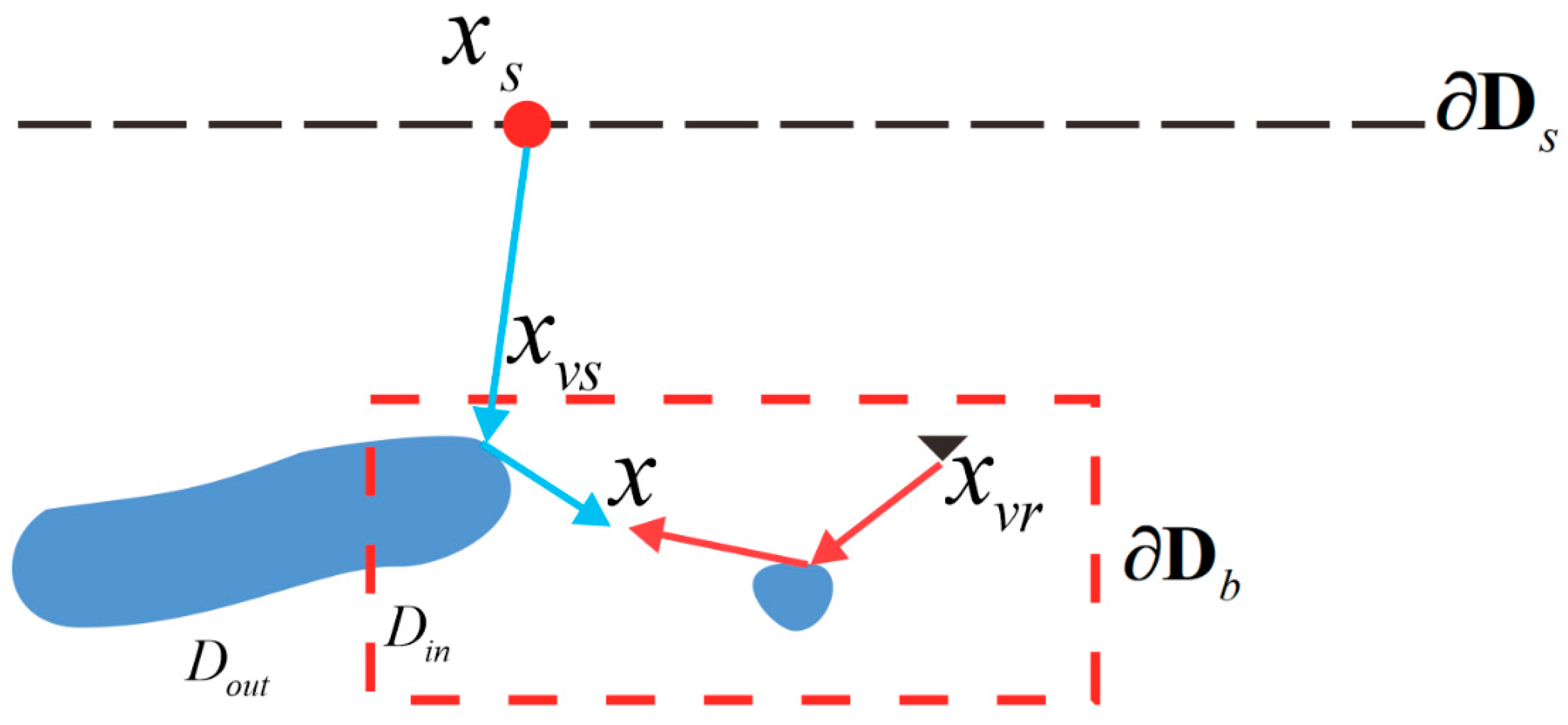

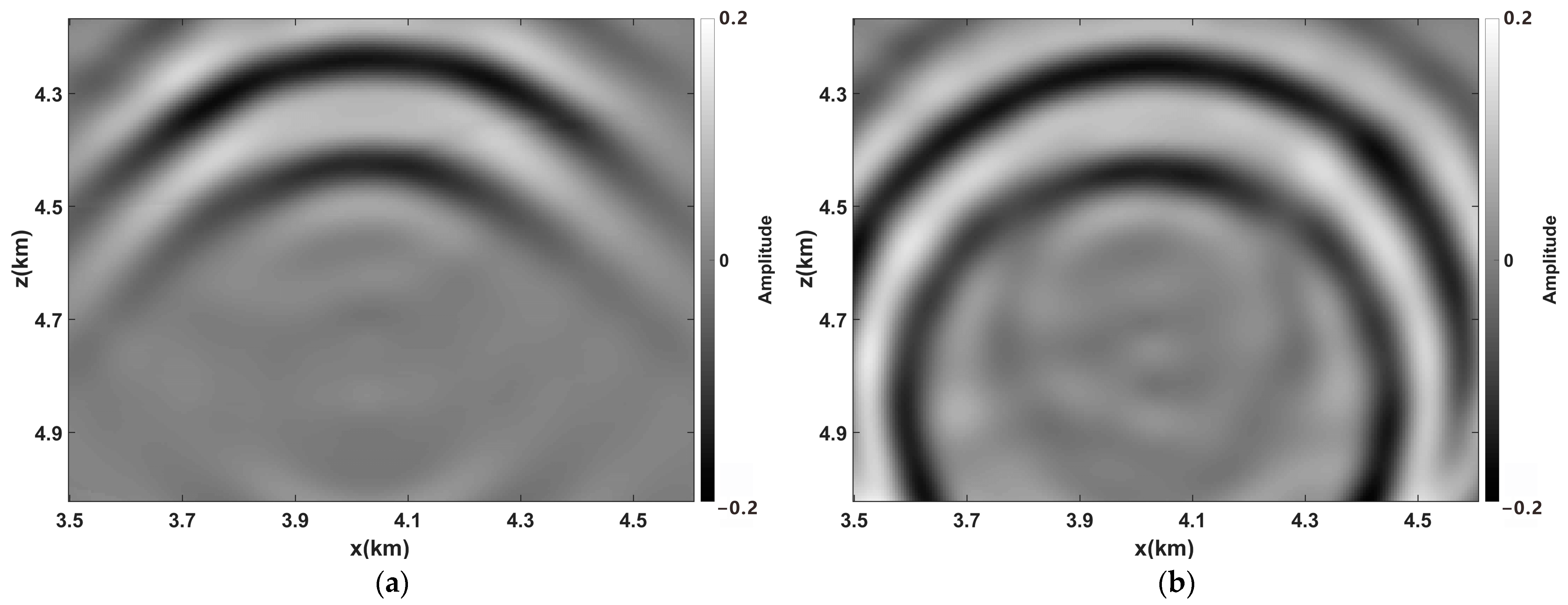


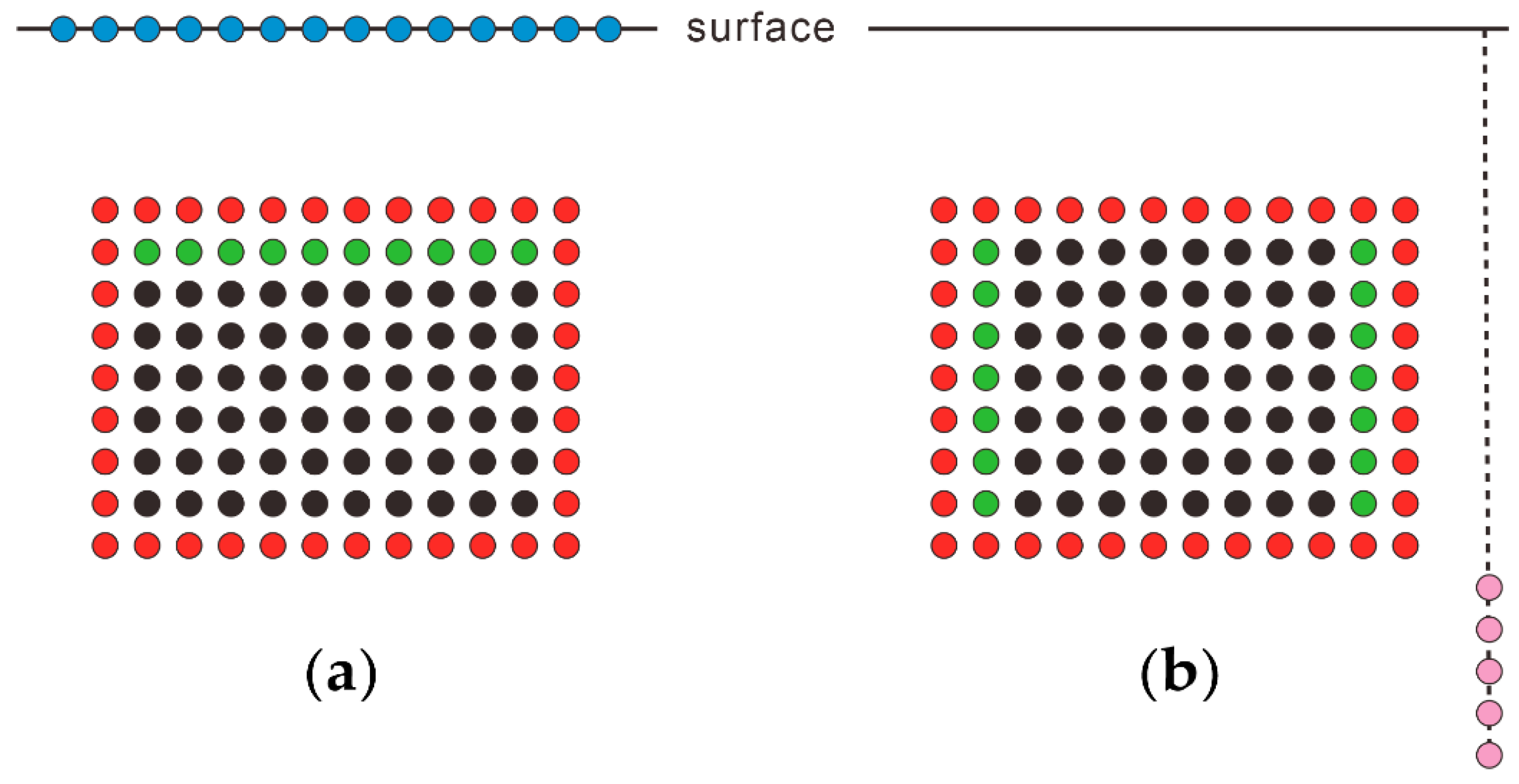
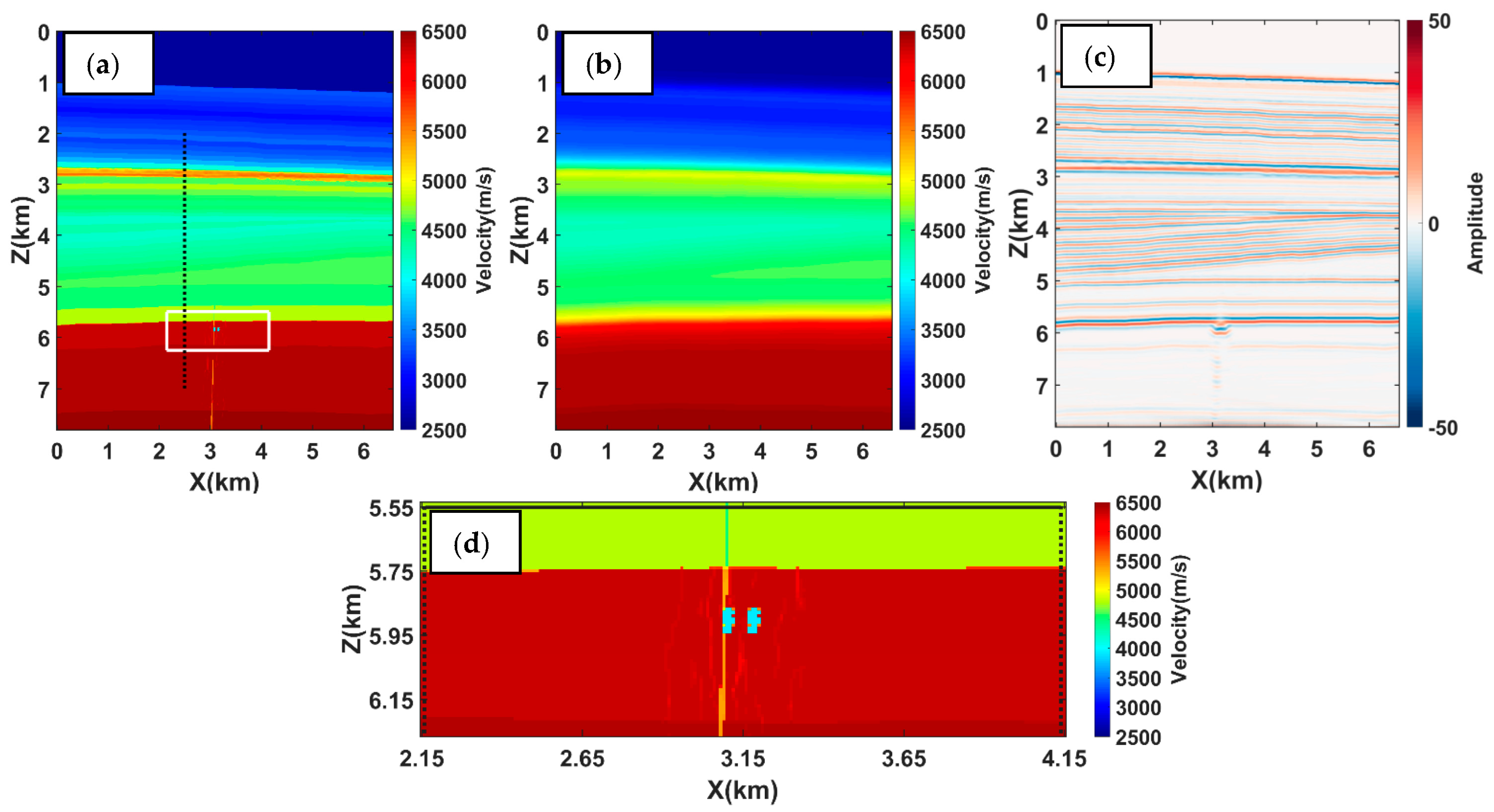

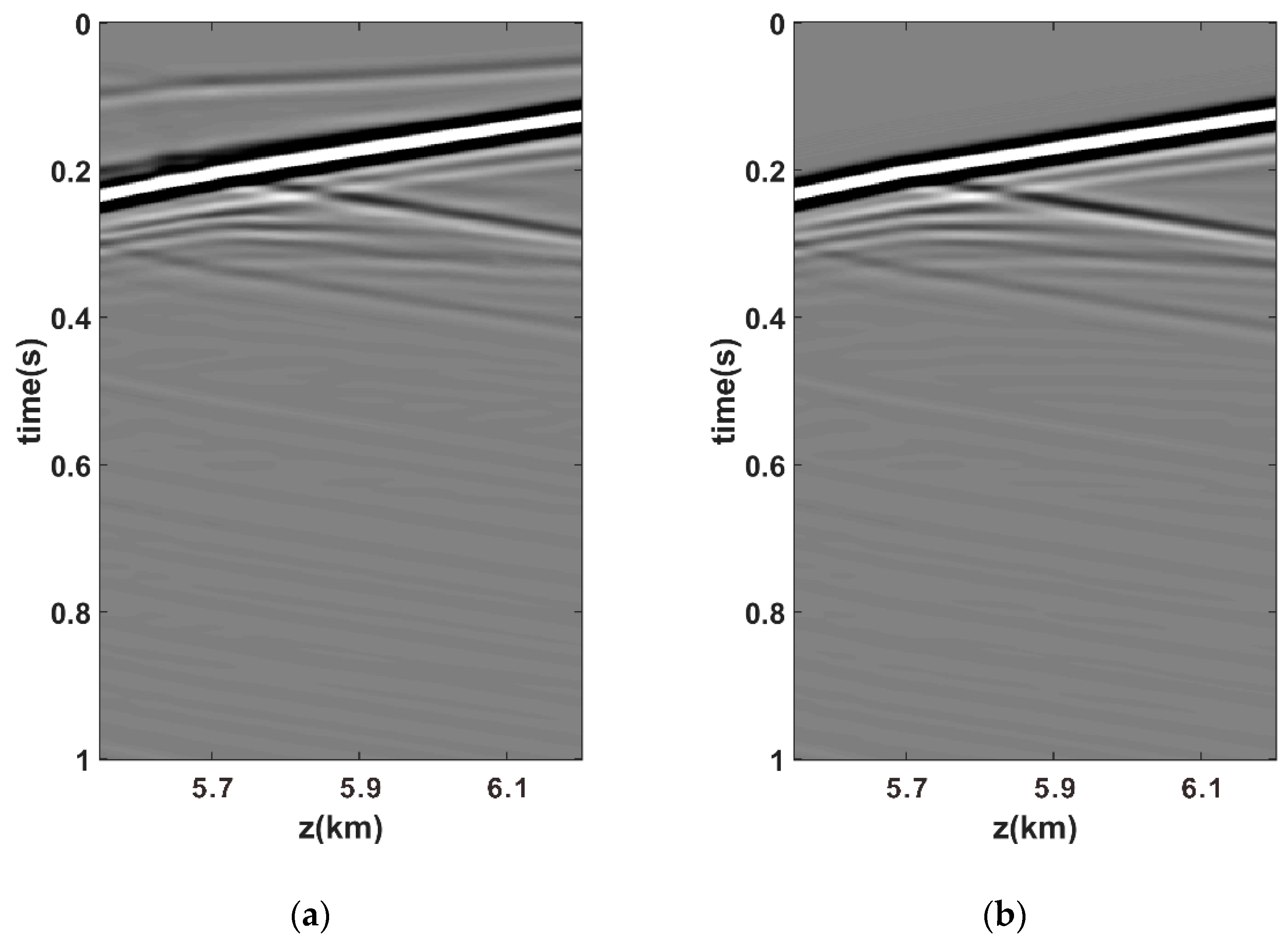
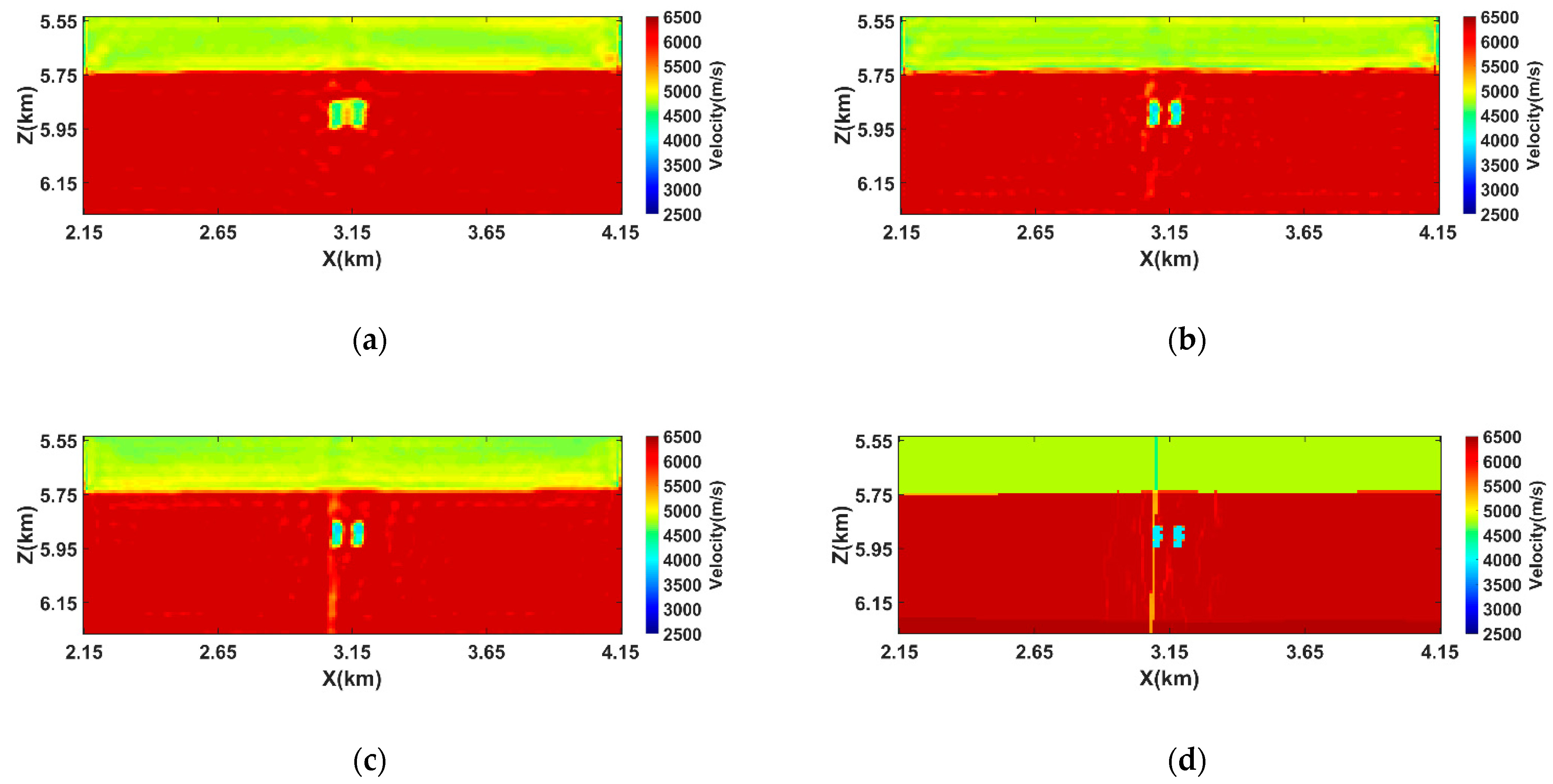
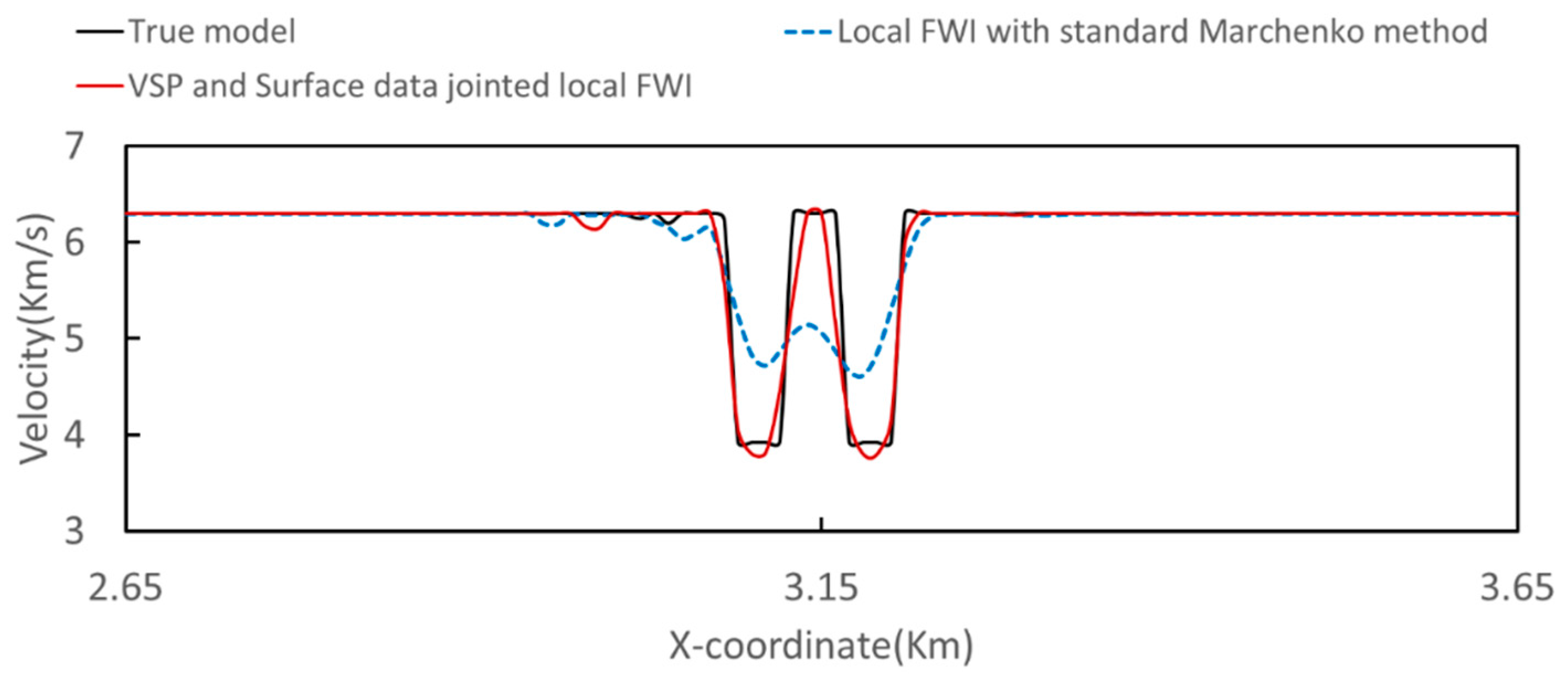
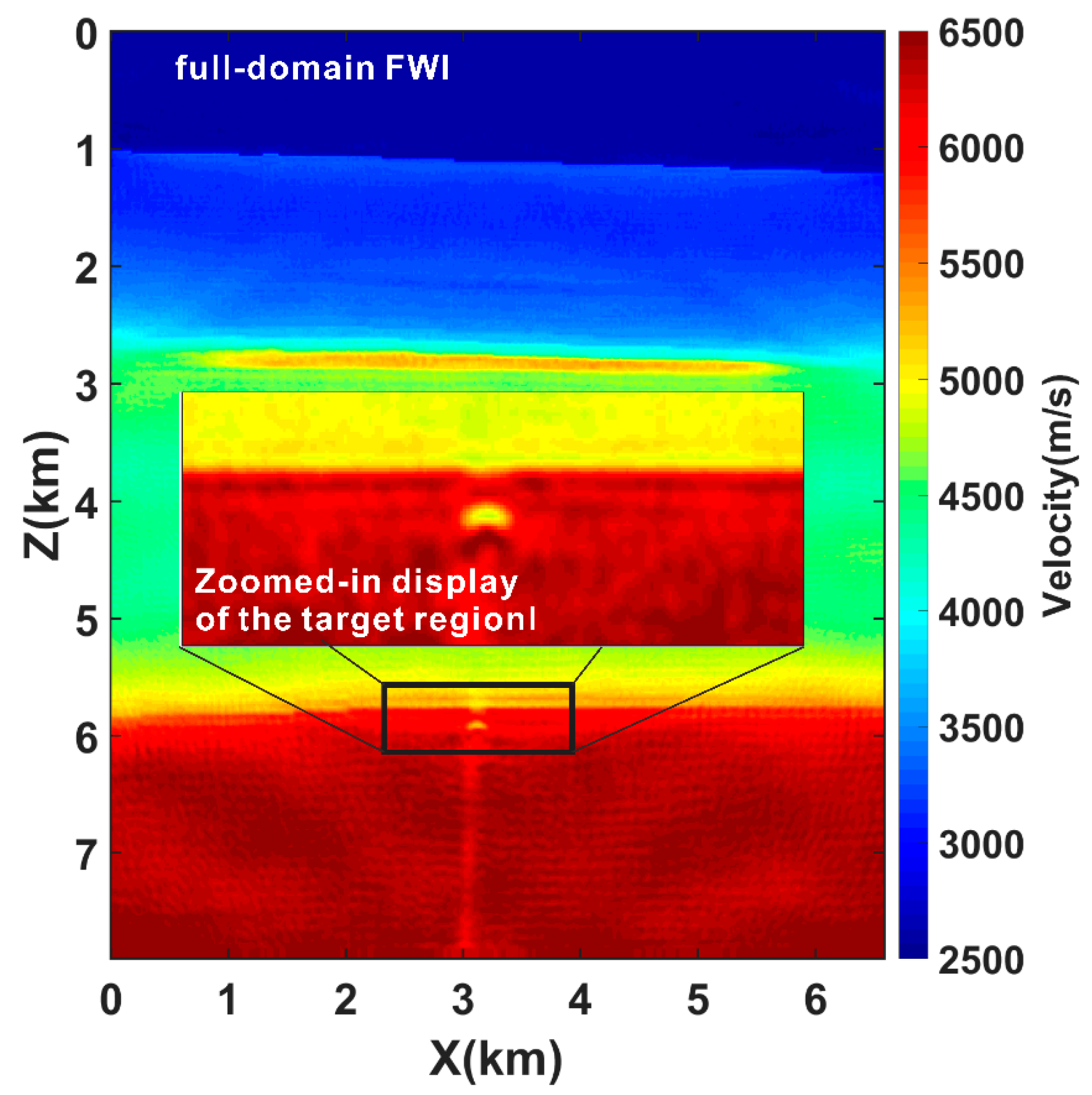

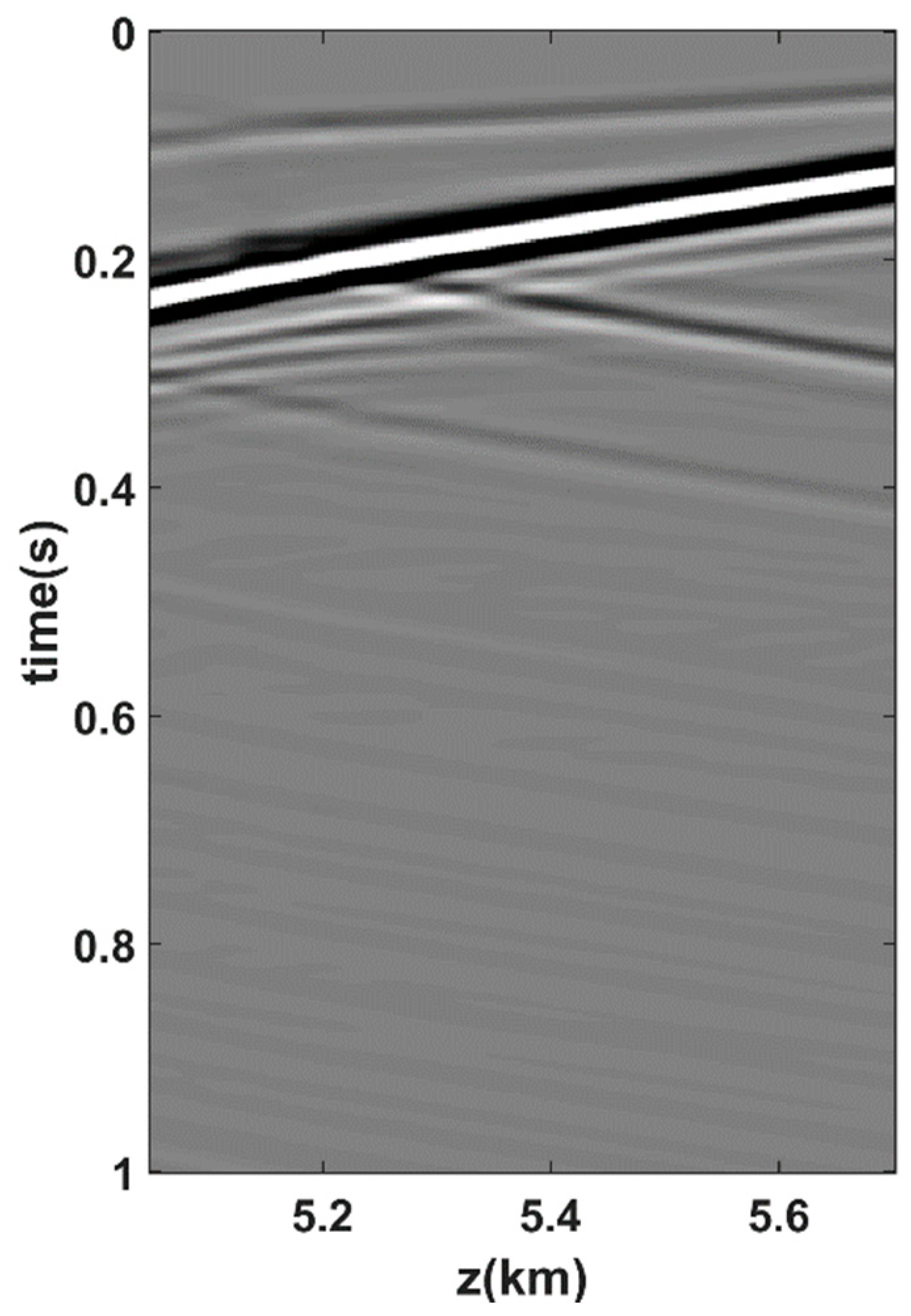
Disclaimer/Publisher’s Note: The statements, opinions and data contained in all publications are solely those of the individual author(s) and contributor(s) and not of MDPI and/or the editor(s). MDPI and/or the editor(s) disclaim responsibility for any injury to people or property resulting from any ideas, methods, instructions or products referred to in the content. |
© 2023 by the authors. Licensee MDPI, Basel, Switzerland. This article is an open access article distributed under the terms and conditions of the Creative Commons Attribution (CC BY) license (https://creativecommons.org/licenses/by/4.0/).
Share and Cite
Li, K.; Huang, X.; Hu, Y.; Chen, X.; Chen, K.; Tang, J. Vertical Seismic-Profile Data Local Full-Waveform Inversion Based on Marchenko Redatuming. Appl. Sci. 2023, 13, 4165. https://doi.org/10.3390/app13074165
Li K, Huang X, Hu Y, Chen X, Chen K, Tang J. Vertical Seismic-Profile Data Local Full-Waveform Inversion Based on Marchenko Redatuming. Applied Sciences. 2023; 13(7):4165. https://doi.org/10.3390/app13074165
Chicago/Turabian StyleLi, Kai, Xuri Huang, Yezheng Hu, Xiaochun Chen, Kai Chen, and Jing Tang. 2023. "Vertical Seismic-Profile Data Local Full-Waveform Inversion Based on Marchenko Redatuming" Applied Sciences 13, no. 7: 4165. https://doi.org/10.3390/app13074165




